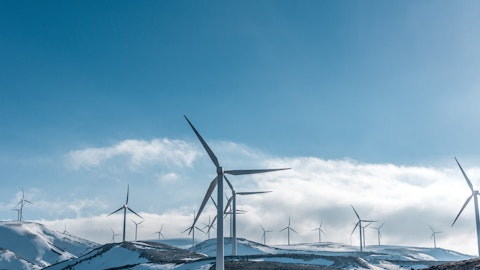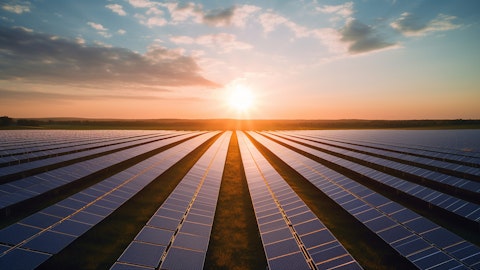We’ll start to see our trouble costs and storm costs that fundamentally will start to decline. And that will help finance this as well. And that’s just one example. Even the transition from coal to natural gas and renewables, that’s creating significant cost reductions, operating cost reduction. So a lot of our CapEx will yield lower operating costs which will obviously be transferred to the benefit of our customers. In terms of revenue growth, we see several of opportunities as we look forward, a lot of discussion in the industry about data centers. Certainly, that will help as we start to land those and we need enabling legislation to get that done. We also see EVs even though they’ve slowed down a bit, we’re still connecting 1,000 EVs a month or more which is encouraging.
And we see that growing and we see the big 3 here working heavily to bring new models to bear. And as a matter of fact, just quickly here, I was on a video call with the President of General Motors. And he was testing a new EV on their track here at Milford. So lots of development activity still on new EVs and bringing those to market. So I think we’ll see that help finance some of these investments. So I would say 2 things, just to summarize, very significant capital agenda, $25 billion over the next 5 years, $50 billion over the next 10 years. So if you’re an investor of DTE, you should be really excited about long-term investment opportunities and the fact that a lot of this investment will help moderate bills over time.
Sophie Karp: That’s very helpful. I also wanted to ask you a quick question on Vantage, right? So I guess to the extent you keep in this business, how should we think about the size of it relative to the utility businesses that you have? Is there a certain kind of like contribution to earnings that you want to keep it under like not let them go beyond? Like what is your thinking there?
Gerardo Norcia: Yes, our investment thesis there is that we want to pursue high-quality investments with low risk and high returns. And we’ve been doing that and that’s working out quite well. But we want to keep it at less than 10% — at 10% or less of earnings contribution as we look forward. And our utilities are growing so quickly that it does give us the opportunity to continue to grow Vantage as well.
Operator: Your next question comes from the line of Angie Storozynski with Seaport.
Agnieszka Storozynski: So just wondering, in the past, I remember there was always this discussion about your approach to coal plant retirements and reliance on the grid versus self-generation. It was always of an impression that you guys were long power. I hope that’s still the case. So just 2 things. As the long growth accelerates and as we are more cognizant of the importance of dispatchable resources, is there a chance that you’re going to make any changes to generate? And number two, as I said, I’m assuming your long power and that could sort of attract data centers, would that simply improve affordability of electric bills for existing customers? Or would it be actually incremental to earnings? Again, I feel like we’re seeing this pickup in the long growth that other [ph] utilities without any necessarily comment an increase in earnings. And so I’m just wondering how you envision it given your generation footprint.
Gerardo Norcia: Great question, Angie, I’ll take them one at a time. So in terms of reserve margins, DTE, when we filed our last IRP, we filed that with adequate reserve margins as we move through our coal plant retirements. And as you know, we’ve built a state-of-the-air combined cycle facility that’s up in operation as part of our coal plant retirement plan. We are converting the Belle River power plant from coal to natural gas which will be a dispatchable — continue to be a dispatchable plant. That will happen in the ’25 and ’26 time frame. In addition to that, we’ve embarked on battery storage which will provide us short-term dispatchability. So all of that fits into the portfolio between now and 2028. That works extremely well.
As we near the end of that — near the next phase of the IRP plan when we want to exit coal completed by 2032, we will need to build more dispatchable generation. And what we’re pursuing there is current technology where we can use natural gas with carbon capture and storage and we highlighted that in our IRP. So we do see more dispatchable generation in our future as we continue our exit from coal. That plant will also be available to burn hydrogen should hydrogen present itself as a viable resource and fuel resource. In terms of growth, very good question. What we see there is if some of this growth accelerates, we will need to build — and the growth that we’re looking at, like data centers, for example, are 24/7 operations. That will need generation that cannot be — and power that cannot be interrupted.
And so we will need 24/7 dispatchable — more 24/7 dispatchable generation and renewable resources. So again, it will be a mix. It does have the potential for accelerating our next IRP should such demand present itself. In terms of impact to customers, we expect that those investments will pay for themselves and actually provide a benefit to customer bills to some degree. So that’s our going-in position and we see that as very possible. It will also add value for our investors because those investments will be in rate base and they’ll attract the typical returns. So, I think it’s a win-win all around.
Agnieszka Storozynski: And based on your discussions, when would this incremental load potentially materialize? Are we talking like 2028 and beyond? I’m just wondering how soon we could see the earnings impact?





